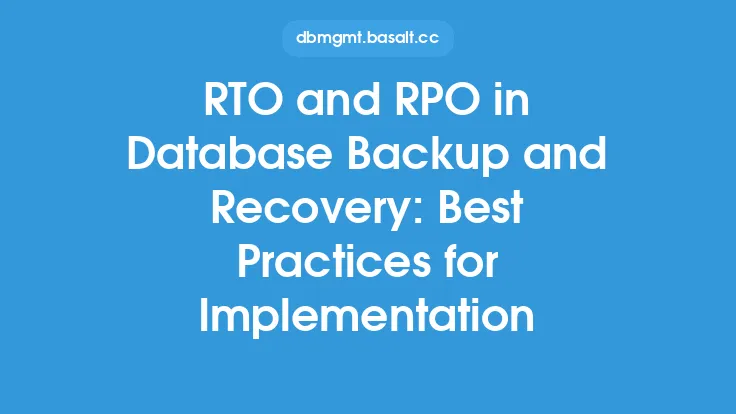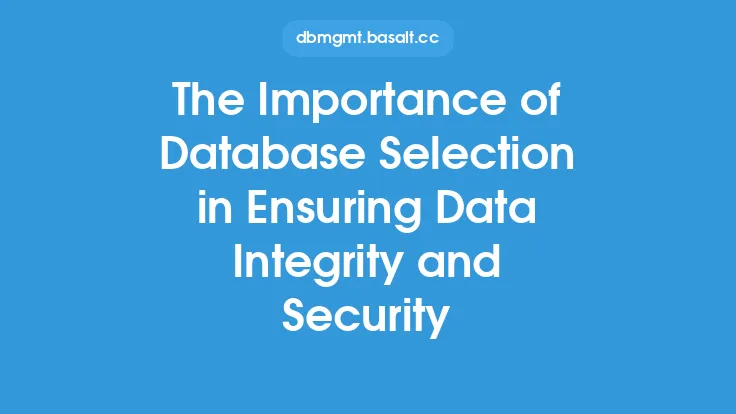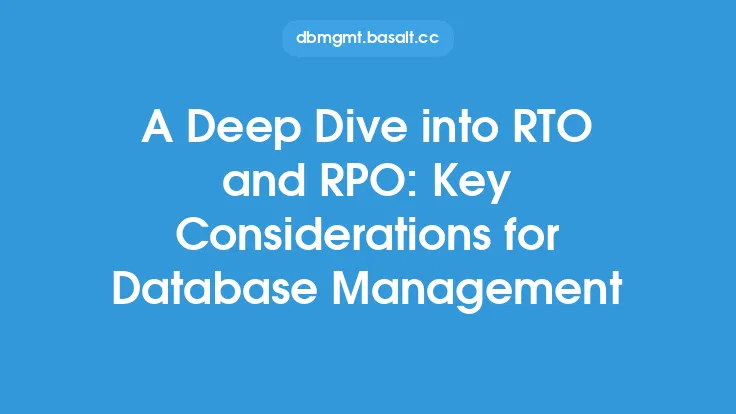In today's fast-paced, data-driven world, databases play a critical role in the operation of businesses across various industries. The integrity, availability, and performance of databases are essential for ensuring business continuity, as they store and manage vast amounts of critical data. However, databases are susceptible to failures, outages, and data loss due to various factors such as hardware or software failures, human errors, cyber-attacks, and natural disasters. To mitigate these risks and ensure business continuity, it is crucial to have a robust database backup and recovery strategy in place. Two key components of such a strategy are the Recovery Time Objective (RTO) and Recovery Point Objective (RPO).
Introduction to RTO and RPO
RTO and RPO are two fundamental concepts in database backup and recovery planning that help ensure business continuity in the event of a disaster or data loss. RTO refers to the maximum amount of time that an organization can tolerate being without access to its database or data after a disaster or outage. It is the time it takes to restore the database to a functional state, allowing business operations to resume. On the other hand, RPO refers to the maximum amount of data that an organization can afford to lose in the event of a disaster or outage. It is the point in time to which the database can be restored, ensuring that the data loss is minimal.
The Role of RTO in Database Business Continuity
RTO plays a critical role in ensuring database business continuity by setting a clear target for the time it takes to recover from a disaster or outage. A well-defined RTO helps database administrators and IT teams to prioritize their recovery efforts, allocate resources effectively, and ensure that the database is restored to a functional state within the specified timeframe. A shorter RTO indicates a higher level of availability and a lower tolerance for downtime, while a longer RTO indicates a lower level of availability and a higher tolerance for downtime. For example, a financial institution may have an RTO of 2 hours, meaning that they need to restore their database to a functional state within 2 hours of a disaster or outage to minimize the impact on their business operations.
The Role of RPO in Database Business Continuity
RPO is equally important in ensuring database business continuity by setting a clear target for the amount of data that can be lost in the event of a disaster or outage. A well-defined RPO helps database administrators and IT teams to determine the frequency of backups, the type of backups to perform, and the retention period for backups. A shorter RPO indicates a lower tolerance for data loss, while a longer RPO indicates a higher tolerance for data loss. For example, an e-commerce company may have an RPO of 15 minutes, meaning that they can afford to lose only 15 minutes' worth of data in the event of a disaster or outage to minimize the impact on their business operations.
Technical Considerations for RTO and RPO
From a technical perspective, achieving a desired RTO and RPO requires careful planning, design, and implementation of database backup and recovery strategies. This includes selecting the right backup tools and technologies, designing a robust backup architecture, and implementing automated backup and recovery processes. For example, database administrators may use techniques such as incremental backups, differential backups, or transaction log backups to achieve a shorter RPO. They may also use technologies such as disk-based backups, tape-based backups, or cloud-based backups to achieve a shorter RTO.
Best Practices for Implementing RTO and RPO
To ensure effective implementation of RTO and RPO, organizations should follow best practices such as conducting regular risk assessments, performing thorough business impact analyses, and developing comprehensive disaster recovery plans. They should also establish clear communication channels, define roles and responsibilities, and provide training to IT teams and stakeholders. Additionally, organizations should regularly test and validate their backup and recovery processes to ensure that they can meet their RTO and RPO targets in the event of a disaster or outage.
Conclusion
In conclusion, RTO and RPO are critical components of a robust database backup and recovery strategy that ensures business continuity in the event of a disaster or data loss. By understanding the roles of RTO and RPO, organizations can develop effective strategies to minimize downtime, reduce data loss, and ensure the availability and integrity of their databases. By following best practices and considering technical factors, organizations can achieve their RTO and RPO targets, ensuring the continuity of their business operations and the integrity of their critical data.





